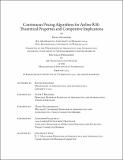Continuous Pricing Algorithms for Airline RM: Theoretical Properties and Competitive Implications
Author(s)
Szymański, Bazyli
DownloadThesis PDF (13.70Mb)
Advisor
Belobaba, Peter P.
Terms of use
Metadata
Show full item recordAbstract
After decades of development of revenue management (RM) systems, airlines have until recently been limited to a set of fixed fare classes and, in turn, price points, to distribute their fare products. The advent of IATA’s New Distribution Capability will allow airlines to forego these limitations, allowing them to quote any fare from a continuous range. In theory, such continuous pricing could increase revenues by extracting more of the consumer surplus, through its ability to offer more granular fares closer to customer willingness-to-pay (WTP). This thesis provides a theoretical assessment and extensions of existing algorithms for continuous pricing, and discusses the market implications of moving away from fixed price points through competitive simulations.
On the theoretical side, we contribute to the understanding of the existing bid price algorithms for single fare quote continuous pricing with static and dynamic optimization, two widely accepted approaches in the airline industry. For the static algorithms, in a simplified single leg, single period setup we prove the uniqueness and convergence of classless continuous Probabilistic Bid Price (ProBP) bid prices as well as the convergence of class-based continuous ProBP to classless ProBP bid prices, answering the question about the equivalence of the two optimizers. As we show, however, these results do not carry over to a realistic setup with multiple time periods.
The dynamic optimization approach with classless Unbucketed Dynamic Programming (UDP) is built on a theoretically more established mathematical formulation. However, in its popular implementation it suffers from an inherent Poisson variance assumption, often considered a major limitation given that demand variance in reality is typically higher than the mean. To address that shortcoming, building on earlier work for traditional class-based RM, we introduce classless UDP with batch arrivals, where multiple customer arrivals are assumed within each DP time slice, leading to higher demand variance in the DP formulation. We show that when actual demand variance matches the batch arrival DP input, the new approach is an improvement over the standard classless UDP: the use of batch arrivals leads to higher airline revenues and flatter bid prices, even though the approach only emulates higher variance and the simulated passengers do not arrive in batches.
Through PODS simulations, we show that through increased responsiveness to demand fluctuations and the ability to quote a closer-to-optimal price, the airline implementing continuous pricing can see revenue gains as high as 3% without affecting the revenues of traditional RM competitors, but that these gains are highly sensitive to airline's price elasticity estimates. To this end, we developed competitor adjustment for continuous pricing: a heuristic adjusting elasticity estimates used for fare quotation based on day-to-day deviations in competitor fares. When limited to price increments, the method was shown to bring further sustained revenue improvements of up to 0.5% for the implementing airline by capitalizing on the differences between conditional and maximum WTP, all while not negatively affecting competitor revenues.
Date issued
2023-02Department
Massachusetts Institute of Technology. Department of Aeronautics and AstronauticsPublisher
Massachusetts Institute of Technology